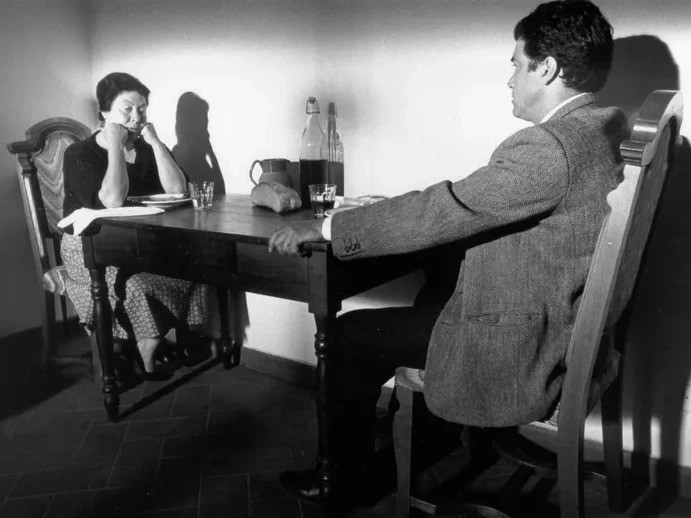
After many years away, Silvestro returns from northern Italy to the Sicilian countryside of his childhood to visit his mother. On his journey, he has conversations with strangers in a port, fellow passengers on a train, his mother, and a knife-sharpener.
EN
“Oscar Pedersen: Is that also what is shown in Sicilia!. Si gira (2001) – which follows the production of Sicilia! (1999) – when Straub points to a screen, commenting on the light?
Jean-Charles Fitoussi: Yes, exactly, when he says that the black and white reminds him of Journal d’un curé de campagne (Robert Bresson, 1951). So that is how we worked as assistants. As mentioned, we were two assistants and we always switched places; travelled back and forth during the night by train. One was on set while the other was in Paris, and vice versa. On set, there were very few things to do because it was so quiet and thought-out. When we were making Von heute auf morgen in Frankfurt, I noticed this, and when we were about to make Sicilia!, I asked if I could film the production. If I was invisible, it would be okay, they told me.”
Oscar Pedersen1
“Most critics have placed the hour-long Sicilia! among Straub-Huillet’s peasants-declaiming-in-a-landscape works, but in many ways it belongs with their musical films, such as Von heute auf morgen (From Today Until Tomorrow, 1997), their rendition of the eponymous Schönberg opera, made just prior to Sicilia! Like Schönberg’s comic one-act, the film is a Kammerspiel shot by legendary cinematographer William Lubtchansky in high-contrast black-and-white and centered on marital discord (Silvestro is visiting his mother to discover why she broke up with his father). Aside from a folk song and the Beethoven string quartet that introduces and ends Sicilia!, the film avoids nondiegetic music, but it is itself structured as a chamber work in four movements, and the idiosyncratic delivery of the baroque dialogue often hits the ear as discordant ariettas and semi-recitatives. Indeed, the rapid volleys of conversation on the train in the second “movement” suggest nothing so much as bug-eyed buffa roulades; and Silvestro’s frequent lists of foods and place names, and his exhilarating exchange in the finale with a knife sharpener—a vocation almost as obsolete as the harquebuses he mentions and the 1.37 aspect ratio that the directors employ—enumerating the joys and insults of life, resemble verismo variations on Leporello’s catalogue aria from Don Giovanni.
Pierre Boulez once said, “I admire people who have obstinately gone their way and explored their personalities to the very end,” citing as an example Cézanne, coincidentally also the subject of two Straub-Huillet films (Cézanne: Dialogue avec Joachim Gasquet [1990] and Une visite au Louvre [2004]). The dauntless duo might have equally qualified for the composer’s esteem, as they stayed their uncompromising course for half a century, at times questioning the judgment even of those who admire their films. Disparaging audiences for complacency, they claimed that it was only “the vices of the bourgeoisie”—a desire for a protagonist who takes an “initiatory journey” and reunites with his mother—that accounted for the comparative popularity of Sicilia! In which case, this critic remains impenitent for indulging said depravity.”
James Quandt2
- 1Oscar Pedersen, "At Work with Danièle Huillet and Jean-Marie Straub. A Conversation with Jean-Charles Fitoussi," Sabzian, 25 Octobre 2023. This article was originally published in Balthazar no. 9, 2023, dedicated to the work of Danièle Huillet and Jean-Marie Straub.
- 2James Quandt, “OPERATIC TENOR: STRAUB AND HUILLET’S SICILIA!,” Artforum, May 2016.

